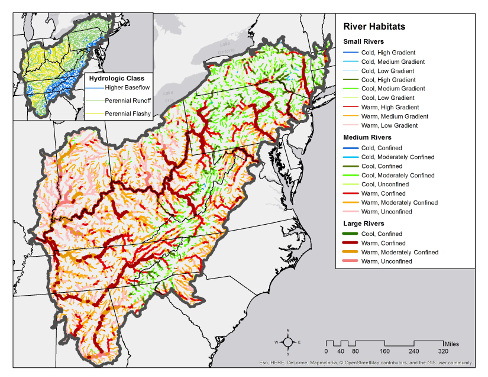The Stream Classification for the Appalachian Region is “Outstanding ... a product that will be of great value to the Appalachian LCC and its stakeholders, as well as to academic researchers”
- John Faustini, Hydrologist, U.S. Fish and Wildlife Service Southeast Region
From the icy, fast-moving creeks of mountains to the slow meandering warm rivers of the Ohio valley, flowing water is the lifeblood of the Appalachian region. The 400,000 miles of streams and rivers that cross the region provide food, freshwater, energy and recreation for people and support a huge diversity of fish, birds, invertebrates and aquatic plants. To facilitate cross-state conservation planning, USFWS’s Appalachian Landscape Conservation Cooperative funded this project to classify and map the region’s freshwater resources.
Using newly available data and a steering committee of 41 aquatic ecologists, conservation planners, and agency biologists representing 17 states, The Nature Conservancy has developed the first comprehensive map of stream and river types in the region. The products include an interactive story map, report, and dataset containing detailed information on every stream and river in the Appalachian region.
Each stream was mapped and classified on six attributes:
- Size: the area drained by the stream.
- Gradient: the steepness of the stream channel.
- Temperature: the mean summer water temperature.
- Hydrology: the frequency, duration, and timing of streamflow.
- Buffering Capacity: the capacity of water to resist changes in pH that would make it more acidic.
- Confinement: the degree that bounding topographic features limit the lateral extent of the floodplain.

This project was funded by the USFWS’s Appalachian Landscape Conservation Cooperative to facilitate multi state conservation planning. It integrates state-based classifications into a single system that provides context for understanding the extent, distribution, threats, and conservations status of streams in the region.

